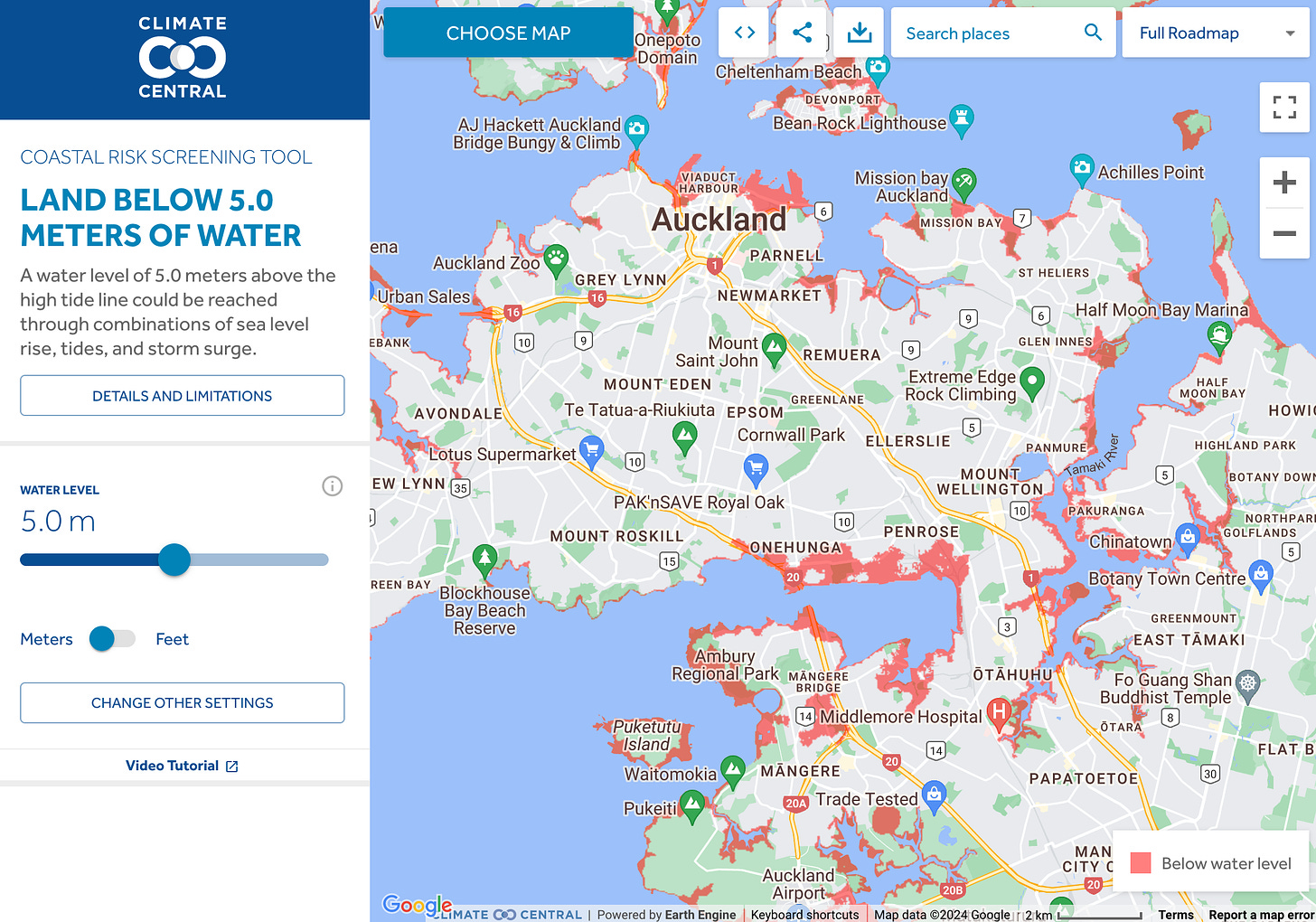
TL;DR: Here’s the top six news items of note in climate news for Aotearoa-NZ this week, and a discussion above that was recorded yesterday afternoon between
and The Kākā’s climate correspondent :Antarctic researchers have been shocked by the speed of events unfolding there over the past two years. A new paper outlines the evidence supporting their belief that a ‘regime shift’ has taken place in Antarctica over the past decade.
A regime shift is an abrupt change in a system’s response to external drivers (a definition proposed by Lenton et al. (2023) ), which may or may not be permanent (a tipping point). The study authors have not considered whether or not this regime shift is permanent, so they are not yet calling it a tipping point, although it is indistinguishable from one at this stage.
The Guardian reports the massive 38.5˚C temperature leap - the single largest temperature increase ever recorded at a meteorological centre on earth – at east Antartica in March, 2022, and outlines concerns that significant sea level rises could occur in the next few decades. The melting of ice sheets and glaciers in west Antarctica could contribute as much as five meters to global sea levels.
This follows hard on the heels of new research in 2022 showing Arctic heating has occurred at four times the rate of the rest of the rest of the world since 1979, a rate of amplification that is double that previously described in the literature. The authors of that paper suggest climate modellers are seriously underestimating the rate of arctic amplification.
A sudden acceleration of polar amplification in both the Arctic and Antarctic simultaneously represents a new and alarming phase in global warming.
Meanwhile, the European Court of Human Rights released a far-reaching decision today, finding that state failure to act sufficiently in response to climate change could constitute a violation of human rights.
(See more detail and analysis below, and in the podcast above. Cathrine Dyer’s journalism on climate and the environment is available free to all paying and non-paying subscribers to The Kākā and the public. It is made possible by subscribers signing up to the paid tier to ensure this sort of public interest journalism is fully available in public to read, listen to and share. Cathrine wrote the wrap. Bernard edited it. Lynn copy-edited and illustrated it.)
The dizzying speed of change in the polar regions
Antarctic researchers have been shocked by the speed of events unfolding over the past two years with the region switching from record highs to record lows in surface temperature and sea-ice cover with dizzying speed. Their belief that the Antarctic has reached an abrupt turning point, shifting it from one state to another, has been laid out, with detailed statistical support, in a paper published this month in The Journal of Climate.
The Guardian quotes Professor Michael Meredith, science leader at the British Antarctic Survey, describing the single largest temperature increase ever recorded by a meteorological centre as “simply mind-boggling”. The 38.5˚C leap was recorded at East Antarctica in 2022.
“In sub-zero temperatures such a massive leap is tolerable but if we had a 40C rise in the UK now that would take temperatures for a spring day to over 50C – and that would be deadly for the population” said Meredith.
The article goes on to discuss the widespread implications of such abrupt changes, to such things as sea levels
“... there is now a real danger that some significant sea level rises will occur in the next few decades as the ice sheets and glaciers of west Antarctica continue to shrink. These are being eroded at their bases by warming ocean water and could disintegrate in a few decades. If they disappear entirely, that would raise sea levels by 5m – sufficient to cause damage to coastal populations around the world.
Five metres of sea level rise would hit coastal cities hard. It would, for example, put Auckland Airport out of action.
Why is this happening, and what does it mean for our future?
Scientists have long understood that global climate change would cause more dramatic warming at the poles than at the equator. This affect, known as polar or arctic amplification, is built into climate models. However, the Northern pole (the Arctic) and the southern pole (the Antarctic) do not behave in the same way, and both ends of the earth have demonstrated a tendency to take us by surprise.
It has recently been established that the rate of warming in the Arctic is double what has been represented in most of the scientific literature to date or anticipated in climate models, while the recent regime shift in the Antarctic has shocked scientists with its early and rapid onset.
Polar amplification is one of the key relationships in climate modelling along with climate sensitivity (how much the temperature rises when you double CO2 in the atmosphere). You can draw a diagonal line on a graph starting with the average temperature in the Antarctic or Arctic to the relatively higher average temperature in the tropics. That line is known as the atmospheric pressure gradient. When the poles warm faster than the rest of the globe, the pressure gradient begins to flatten and this in turn weakens linked ocean and atmospheric currents, although the dynamics of this are still highly contested within the scientific community.
In the Northern Hemisphere, one important ocean current that is known to be weakening with potentially devastating consequences for many regions, is the Atlantic Meridional Overturning Circulation (AMOC). Arctic amplification is believed to be the main cause of the AMOC’s recent weakening. (See our previous coverage of this)
The major Southern Hemisphere ocean and atmospheric currents include the El Niño-Southern Oscillation (ENSO), the Southern Annular Mode (SAM), and the Indian Ocean Dipole (IOD). These redistribute heat from one place to another and are key drivers of the climate conditions and weather events that we experience. Australia’s national science agency CSIRO released a report earlier this year highlighting the lack of Southern Hemisphere specific knowledge about tipping points and their effects.
Changes in polar amplification, particularly ones that we don’t fully understand, are a big deal.
What is a ‘regime shift’?
Satellite data, available since 1979 showed a trend of growing ice coverage over several decades in the Antarctic, peaking in 2014 with a record high. Over this same period, the Arctic region was showing steadily increasing temperatures and sea-ice losses, as one might expect in a warming world.
The difference has to do with the fact that the Northern Hemisphere has much more landmass, while the Southern Hemisphere has much more ocean. Oceans have absorbed 90% of climate heating to date and this delayed the onset of polar amplification in Antarctica. This changed after 2014 with an abrupt shift toward extremely low sea ice cover in multiple summers (record lows were recorded in 2016, 2022, 2023), that extended into the following winter seasons.
The 2023 winter maximum was one million km2 lower than the previous record low. Researchers have found that the variability of the summer sea-ice record has doubled over the past decade, and this has been accompanied by a longer season-to-season sea ice memory.
Generally, the primary driver of Antarctic sea-ice variability is the atmosphere, but the measured changes over the last decade cannot be explained by atmosphere alone. Some physical mechanism of change has shifted. This is likely to have something to do with the ocean, and the amount of mixing between different heat stratas. However, there is insufficient monitoring of ocean mixing at Antarctica, so there is no physical evidence to support the theory. Scientists are forced to rely on statistical evidence that provides a less direct measure of the shift’s impact.
In addition to increased variability, they are now finding that winter sea ice coverage is predictive of summer sea ice coverage, showing that events have become more persistent. This never used to be the case. The increased correlation that has been observed over the past decade is also visible at key times in the paleo-climate record, as a precursor to abrupt changes in Earth’s history. Increased variability in key measures is known to act as an early warning signal ahead of tipping points and is sometimes referred to by experts as ‘flickering’.1
According to the study, these two changes are consistent with a regime shift having taken place over the last decade. A regime shift is an abrupt change in the system’s response to external drivers (a definition proposed by Lenton et al. (2023) ), which may or may not be permanent (a tipping point). The study authors have not considered whether or not this regime shift is permanent, so they are not yet calling it a tipping point.
Doubling of Arctic Amplification
In 2022, a study in the journal Nature came out showing that the Arctic has warmed nearly four times faster than the rest of the planet since 1979 . The study authors warn that climate models are seriously underestimating the magnitude of Arctic amplification.
“Everybody knows [the Arctic] is a canary when it comes to climate change,” Peter Jacobs, a climate scientist at NASA’s Goddard Space Flight Center, told the journal Science. “Yet we’re misreporting it by a factor of two. Which is just bananas.”
They suggest two reasons why the reported rate of amplification has been out of whack.
One is just that the commonly used estimate of Arctic warming as double the rate of the rest of the world was accurate in the past but had become outdated. The second reason was that estimates can vary depending on the timeframes used and where you situate the southern boundary of the Arctic circle. In this study they used the period after 1979, from which satellite data was available and used an accurate southern boundary for the Arctic Circle of 66.5˚N. You would get smaller amplification ratios if you used a boundary such as >60˚N, that corresponds with latitudinal lines commonly used on maps, but which includes more land area (and less sea ice loss).
Acceleration of polar amplification in both the Arctic and Antarctic simultaneously represents a new and alarming phase in global warming.
Climate inaction a human rights issue, the brewing insurance nightmare, more shattered records
In other climate news:
In a powerful and far-reaching decision, the European Court of Human Rights has ruled that inadequate policy action to address climate change is a violation of human rights. The case was brought by a group of older Swiss women who claimed that their age made them particularly vulnerable to the effects of heat waves related to climate change. The court agreed that Switzerland’s efforts to address climate change had been ‘woefully inadequate’. The binding ruling will directly influence all 46 European countries in which the European Court of Human Rights has standing and may have impact beyond.
Homeowners are choosing to under-insure their houses and ratchet up their excesses as they struggle to pay for massive increases in insurance premiums, RNZ reported this week. They warn that it is merely a taste of what is to come according to leading researchers. Climate change and disaster economics researcher Ilan Noy has previously told RNZ that premiums would continue to go up as climate change increased the risk of natural hazards such as flooding and landslips. They describe cases where people are facing increases in annual premiums of up to 60%.
The tenth straight month of shattered global temperature records continues to alarm climate scientists, some of whom are expressing concerns that waiting to see if the anomaly is the result of natural variation or a signal of accelerated warming may leave too little time to act. The last twelve months has seen average temperatures exceed pre-industrial levels by 1.58˚C. “If the anomaly does not stabilise by August – a reasonable expectation based on previous El Nino events – then the world will be in uncharted territory. It could imply that a warming planet is already fundamentally altering how the climate system operates, must sooner than scientists had anticipated.” Gavin Schmidt, director of Nasa’s Goddard Institute for Space Studies (successor to James Hansen).
Key Papers:
Hobbs, W., Spence, P., Meyer, A., Schroeter, S., Fraser, A. D., Reid, P., Tian, T. R., Wang, Z., Liniger, G., Doddridge, E. W., & Boyd, P. W. (2024). Observational Evidence for a Regime Shift in Summer Antarctic Sea Ice. Journal of Climate, 37(7), 2263-2275. https://doi.org/https://doi.org/10.1175/JCLI-D-23-0479.1
Rantanen, M., Karpechko, A. Y., Lipponen, A., Nordling, K., Hyvärinen, O., Ruosteenoja, K., Vihma, T., & Laaksonen, A. (2022). The Arctic has warmed nearly four times faster than the globe since 1979. Communications Earth & Environment, 3(1), 168. https://doi.org/10.1038/s43247-022-00498-3
Ka kite ano
Bernard and Cathrine
We talked about this article from The Conversation about the RV Belgica being trapped in ice in Antarctica in 1898, and what that taught scientists about seas now warming around the continent.

















Share this post